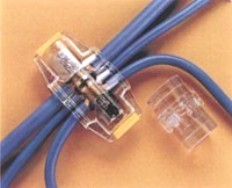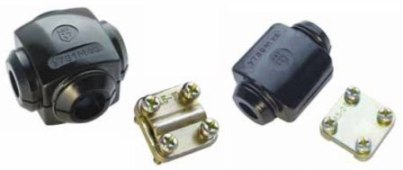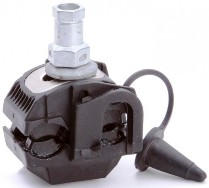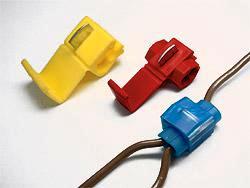Categories: Featured Articles » Electrician at home
Number of views: 183,928
Comments on the article: 3
Wiring Methods
 Very often, electricians have to connect the electrical installation to an existing line, passing by in relative proximity. In other words, it is necessary create branch wire.
Very often, electricians have to connect the electrical installation to an existing line, passing by in relative proximity. In other words, it is necessary create branch wire.
An example is connecting a private house to a 0.4 kV overhead line or connecting apartment electrical panel to the access electric risers. In both of these cases, the line passes, possibly very close by - here they are, the coveted 220 or 380 volts with the necessary reserve for power, at hand. But how to connect to them?
Since this problem is widespread and long-known, there are already quite a lot of options for solving it, and in this article we will try to consider them in detail.
The very first way to create a branch that comes to mind is the good old twisting. There’s no reason to be smart - if the wire is insulated (SIP, for example), then it is cleaned at the point of contact, and the branch line is wound on it with a large number of turns to ensure a large contact area.
Of course, those who decide to twist will have to reckon with the fact that:
- in the book, which is sacred for every electrician, - PUE - they talk about twisting very disapprovingly and practically anathematize them. Therefore, the electrician who performed the twist takes on increased responsibility;
- twisting is possible only if the material of the wire trunk and branch line is the same. That is, copper - to copper, aluminum to aluminum. Otherwise, the twist will not last long and can cause the most serious problems;
- Twisting is worth doing if you are sure that you will do it well and efficiently. If in doubt about your experience and qualifications, use special compresses or pads.
Fig. 1. DKS Universal Branch Terminal Block
Pads approved by PUE. But there are also a few buts. First, to use the terminal block, the trunk wire must be cut. This is completely undesirable. Secondly, terminal block - This is a screw connection that needs systematic maintenance and pulling contacts.
This is also not very convenient. Well, and thirdly, the terminal block is practically not protected from atmospheric precipitation or from mechanical influences. In short, the reliability of the tap-off terminal block is very low. Therefore, it is better to use branch clamps.
And such compresses are available in a fairly large assortment. The most popular among them are the so-called "Nuts". Their design is as follows: the main and branch wires are pressed from different sides to the contact plate of anodized steel using four screws and plates with grooves. All this “sandwich” is closed by a carbolite body, which is pulled together by two spring rings.
Fig. 2. Branch clamps ("Nuts")
The marking of “nuts” includes the letter “U” and a three-digit item number. Nuts are good because they allow you to connect aluminum and copper wires, since the design of these clamps eliminates their direct contact - the steel plate is the "intermediary". In addition, to connect the nuts, the main wire does not need to be cut, and the cross-sections of the connected wires can be very different: from 4 to 150 square meters. mm for the trunk wire and from 1.5 to 120 square meters. mm for the branch.
“Nuts” is, of course, good, but I would like more. In particular, it is not very convenient that for wire connections they must be cleaned from insulation. And under stress, installing “nuts” is not uncomfortable - it is simply dangerous. In addition, the degree of protection of the “walnut” squeeze against external influences often leaves much to be desired - just IP20.
The above disadvantages are deprived piercing clamps. These clamps are tight, do not require stripping of the main wire, which means that they do not impair its performance. The whole secret is in special clamping plates with teeth that can pierce the insulation and provide electrical contact with the wire.
The tightening force of the compression bolts is regulated by a detachable hex head, hence it follows that the piercing clamps are designed for single use. The heads of the clamping bolts are electrically isolated from the contact plates, so the installation of piercing clamps can be done even when energized. Most often, such clamps are used when installing overhead lines with a SIP wire.
Fig. 3. Sealed piercing clamp ZPO
When installing branch lines in a workshop or apartment building, it is more logical to use OV type compresses. They could also be called “piercing”, and their application does not require any tool or special skills at all.
The connected wires without stripping the insulation fit into a clip that just snaps into place. In this case, the brass connector punctures the insulation of the wires and provides a reliable electrical connection. However, the OV connect copper and aluminum wires with a maximum cross section of only 6 square meters. mm., in addition, the cross section of the trunk and branch wires should be approximately the same, therefore they are not used very often.
Fig. 4. OT couplers
The considered devices for performing branching wires cannot be unequivocally classified as “best” and “worst”. For a specific situation, task and object, a certain branch compression is suitable, and the electrician must accurately select it. Then the branch will last a long and reliable.
Alexander Molokov
See also at bgv.electricianexp.com
:




